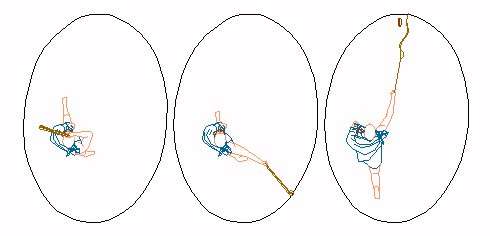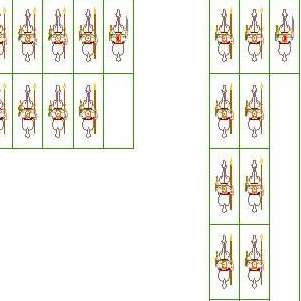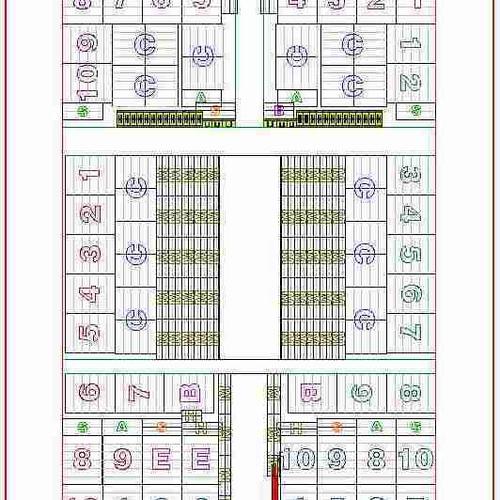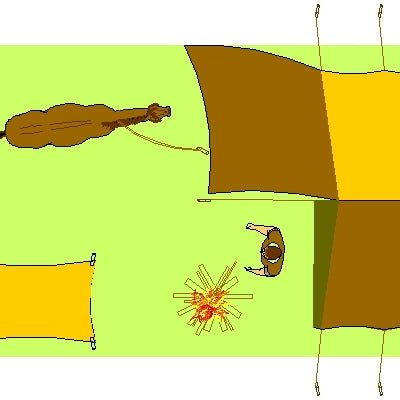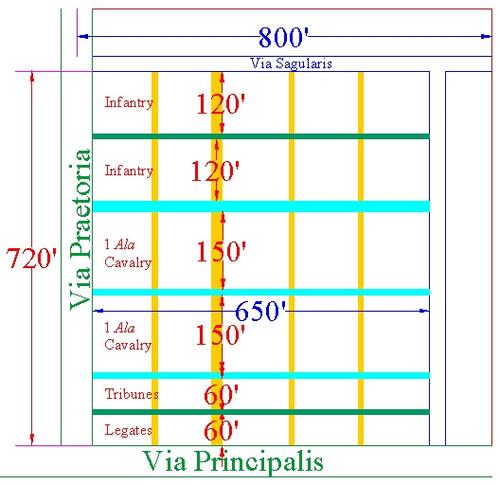The skirmishers
Veles, funditor and sagittarius
Three types of skirmishers are shown in this drawing. The first three figures are velites used in the early republic. They were skirmishers who threw light javelins and were protected by a shield. They wore animal skin headdresses. The center three are funditori, slingers, and the three on the right are sagitarii, archers. The funditori and sagitarii were used in the later republican armies. In the sections following this, models for legion formations using the two style of skirmishers are shown. For the sake of simplicity, the velites are identified with the 'republican army' and the funditori and sagitarii with the 'imperial army', even though the latter two actually appeared in the late republic.
The drawing below shows three velites on the left. They have animal skins over their helmets, are carrying the 'acorn'-bos shield and four or 5 short javelins or darts; those depicted here are 48" long. Since the velites needed speed and agility to close, throw and evade they probably kept a fairly wide spacing; those in the drawing below are on 4 foot spacings.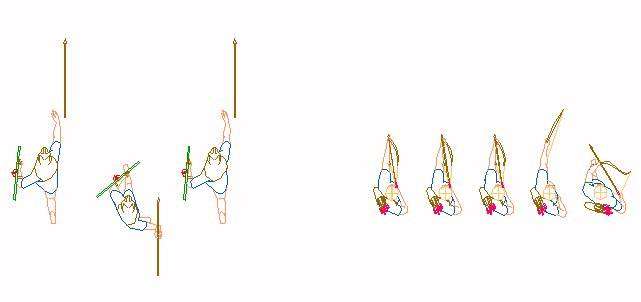
Five sagitarii are shown on the right. They have a 1.06m (42") bow and arrows 889cm (35") long. They could have been grouped fairly close together, the figures are shown on 0.78m (2.6') spacings.
The slingers, funditori, are described as being trained to swing their slings once around their heads and release. The slings depicted here are 61cm (24") long and would require adequate room when used. The ovals illustrate the arc traveled by the sling. To provide the necessary space the funditori are shown on 2.3m (7.5') spacing.
Some funditori may have carried shields, these are shown without shields. Their supply of missiles is shown carried in a fold of their garment.
The sling shot was either lead or clay or small stones. The lead shot recovered averages about 4cm (1.75") long and weighs about 113 grams (1/4 pound.
Arther Ferrill notes that if the sling were swung underhand through a vertical plane then the spacing between the funditori could be much closer. The drawing below shows the underhand swing on the left. These funditori are on 4' centers, which would seem to be enough. Those on the right are on 7' spacing.
Estimates of the ranges of the weapons
The general function of the skirmishers was to harass the main body of the enemy infantry, not the enemy skirmishers. Since the missiles were being directed against a large compact body of troops the model postulates the use of the missile weapons at their maximum ranges, sacrificing accuracy for distance. More information on trajectories and how they are determined is available in the Trajectory Calculator.
Range of the javelin
The maximum distances of a hand thrown light javelin can be estimated from the records of the Olympic javelin. At the turn of the century the Olympic Games were renewed.. The first modern javelin event was held in 1908 with a gold medal throw of 54.25m (178’). Current records are much greater, reflecting improvements in training and equipment. For the purposes of estimating ancient capabilities, performances in the first modern games are probably a better indicators. If the best throw that the world's best athletes of 1908 could achieve was 54 meters, then the average throw of an ancient skirmisher can hardly have exceeded 2/3 of that distance. This would give an average throw of about 37m (120’), with maximum distances of, perhaps, 48m (150’).
Range of the arrow
There are two types of bowshot, direct and lofted.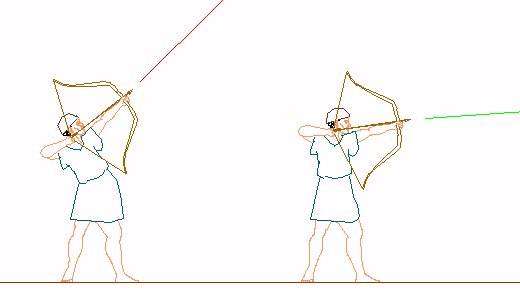
A direct shot is accurate at short range and could be targeted on specific individuals. The figure on the right is shooting at an angle of 7 degrees. This is the model used for direct archery.
The lofted shot is launched at a 45 degree angle to reach the maximum distance. This is depicted in the figure to the left. A lofted shot would not be accurate against individuals but could be used against formations.
Direct bowshot
Direct bowfire would have had a shorter range, especially if any accuracy was expected. Modern field archery courses use 60 centimeter targets for a 60 meter range. Modern bowhunters discuss practicing at 50 meters but when it comes to hunting they prefer to get within 35 meters. Japanese martial artists specializing in archery shoot at 1 foot targets about 75 feet away.
For the purposes of modeling it is assumed that enemy archers would not position themselves within direct bowfire range of each other. Those above are shown with 50 meters between the two opposing archers. This would seem to be a the minimum safe distance. The preferred distance would be well outside of the range of direct bowfire, as shown below.
Lofted bowshot
The average range of lofted bowfire was probably about 183m (200 yards). One author, Watson, states that ancient archers and slingers practiced at targets 180m (600’) away. A modern military historian, Foulkes, estimates the range of the English longbow at 183m (200 yards) to 228m (250 yards) with a reported maximum range of 265m (290 yards). 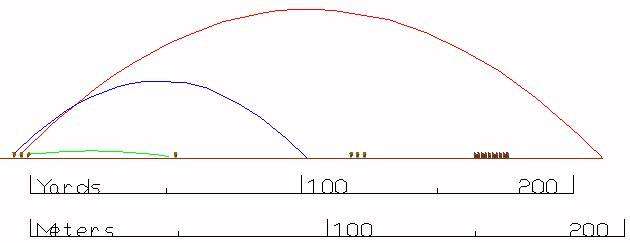 This drawing shows the archers on the left shooting three types of shots. The green arc is a direct bowshot at the opposing archers. In this example, a lone enemy archer has advanced into 'no man's land.' He is shown at the absolute margin of safety, any closer and he could fairly easily be picked off. The purpose for such an advance would be to achieve greater range, as is shown in one of the drawings below.
This drawing shows the archers on the left shooting three types of shots. The green arc is a direct bowshot at the opposing archers. In this example, a lone enemy archer has advanced into 'no man's land.' He is shown at the absolute margin of safety, any closer and he could fairly easily be picked off. The purpose for such an advance would be to achieve greater range, as is shown in one of the drawings below.
The main body of archers is shown as stationing themselves just beyond the blue arc. They are well outside of direct bowshot range. Although they are within lofted range, the target of the skirmishers is the army behind them and they would be relatively safe.
For the sake of illustration, both armies are represented in the traditional legion formation with wide gaps between the first and second lines of cohorts. In the drawing immediately below only the ranks of the first line are visible, the second and third lines would be beyond the red arc.
The blue arc is a weak shot and the red arc is a strong shot. The enemy formation which is the target of the lofted flights of arrows is shown drawn up about 50 yards behind its own archers. Most arrows would fall between these extremes.
The drawing below shows how the lone archer who has advanced to the minimum safe distance could reach the second line of cohorts with a powerful shot.
The following drawing is somewhat complicated. The top half shows the side view of the archers as in the first drawing, but in smaller scale. It shows the maximum range (the red arc) of bowfire from the normal position of the skirmishers. The bottom half shows a top view of the legion formation with the sets of six squares representing a cohort. It was illustrated in Legion Formations as 'The 4800 Man Legion of Marius.' To the left is the blue army with its solid line of skirmishers out front. To the right is the red army, both depicted as legions. The side view and top view are both drawn to the same scale. The red line between the first and second line of red cohorts on the right shows the maximum distance enemy arrows could reach from the regular skirmish position. As was shown above, the second line could only be reached by archers willing to advance to the very margin of safety.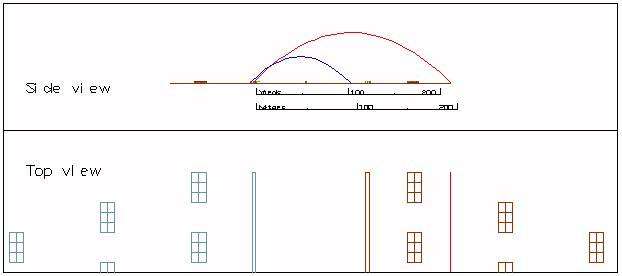
Range of the slingers
Estimates of the likely range of the slingers are guesswork. Some authors claim range of 42.6m (140’) but do not give a rationale. This number seems low. To a certain extent the sling might be compared to the Olympic hammer throw, both throw an object from a whirling circle. While modern Olympic hammer throwers can reach over 76m (250’) with a 7.25kg (16 Lb.) hammer; the winning hammer throw in the 1900 games reached only 49.68m (163’). Though the ancient slingers used a much smaller weight they are said to have only twirled the sling once; this would not generate the same velocity as hammer throwers achieve with several rotations. Nevertheless, the range should have been considerably more than 42m (140’). It does not seem unrealistic to assign a range comparable to that of bowshot, 183m (200 yards).
In favor of a range similar to that of the bow is that, if the bow had a significantly greater range than the sling, then bowfire would have been clearly superior and slingers would not have been utilized. Unless the ranges of the weapons was similar the slingers would have been unable to defend themselves against opposing archers who could have decimated them from a safe distance.
Conclusion
For the purposes of modeling the average range of lofted volleys for the weapons is set at 36m (120’) for the javelin and 183m (600’) for both the archers and slingers. Direct fire for the bow probably had a range of 35m to 50m, similar to modern hunters. Direct fire for the javelin or sling would be a guess.


